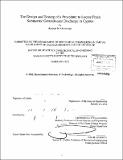The design and testing of a procedure to locate fresh submarine groundwater discharge in Cyprus
Author(s)
Olesnavage, Kathryn M
DownloadFull printable version (18.66Mb)
Other Contributors
Massachusetts Institute of Technology. Dept. of Mechanical Engineering.
Advisor
Chryssostomos Chryssostomidis.
Terms of use
Metadata
Show full item recordAbstract
The aim of this collaborative project between Massachusetts Institute of Technology (MIT) and Cyprus Institute was to develop an experimental procedure for identifying fresh submarine groundwater discharge (SGD) in Cyprus. SGD is a flow of water from coastal aquifers into the ocean driven by a hydraulic gradient and other forces. Understanding SGD is crucial for informed groundwater management. In some cases, SGD creates submarine springs which can be tapped to provide supplementary freshwater. This is particularly enticing for countries such as Cyprus, where energy- and cost-intensive desalination plants are necessary to meet freshwater demand. A preliminary protocol for locating SGD was developed based on a review of literature and interviews with experts. The protocol was tailored to suit resources available in Cyprus. Because groundwater temperature typically deviates from ocean water, an infrared camera mounted on a manned aircraft was used to obtain an ocean surface temperature map. Areas exhibiting temperature anomalies were revisited by boat to measure salinity in situ using a conductivity, temperature and depth sensor (CTD). This protocol was tested in Chrysochou Bay, selected based on relatively high estimates of SGD from published water mass balances as well as recommendations from local fishermen. The designed method proved effective; areas of anomalous salinities and temperatures were found. However the protocol can be improved based on experience gained through this study. Manned aircrafts are unfit for a large-scale study due to high costs, flight restrictions, and lack of appropriate navigational equipment on accessible vehicles. Unmanned aerial vehicles are more suitable for a full-scale study. Additionally, obtaining a salinity profile by a series of point measurements, as with the CTD, is time-consuming. A towed resistivity array would provide similar salinity profiles in a fraction of the time. A thorough investigation of SGD is planned in Cyprus in the spring, when SGD is highest. This paper presents a recommended procedure for the spring investigation based on the results of this study.
Description
Thesis (S.B.)--Massachusetts Institute of Technology, Dept. of Mechanical Engineering, 2012. Cataloged from PDF version of thesis. Includes bibliographical references (p. 50-51).
Date issued
2012Department
Massachusetts Institute of Technology. Department of Mechanical EngineeringPublisher
Massachusetts Institute of Technology
Keywords
Mechanical Engineering.